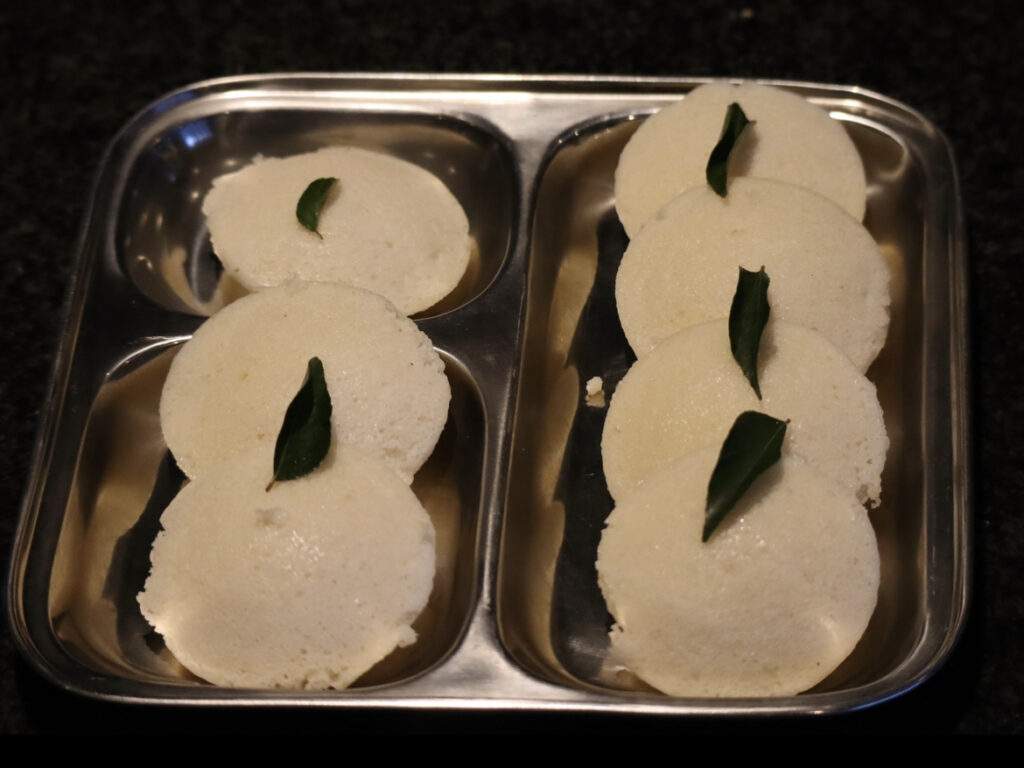Idli (also spelled as idly) is a popular and traditional South Indian dish that is enjoyed as a breakfast item but can also be consumed as a snack or served for dinner. It is a staple food in South India and is known for its simplicity, lightness, and nutritious qualities.
Ingredients: Idli is primarily made from a batter consisting of fermented rice and urad dal (split black gram). The rice and urad dal are soaked, ground, and then allowed to ferment overnight, which gives idli its characteristic fluffy texture and slightly tangy taste.
INGREDIENTS
- 1/2 Cup Urad dal
- 1 1/2 Cups Idili Rice or Normal Rice (not basmati)
- 1/4 Teaspoon Fenugreek Seeds
- 1/4 Cup Pawa (Flattened, Rice)
- 1 Teaspoon Salt
- Water
METHOD
- Begin by soaking urad dal and fenugreek seeds in one bowl, idli rice in another bowl, and powa in separate bowls with enough water to cover the grains. Allow them to soak for 4 hours.
- After soaking, grind the urad dal and fenugreek seeds with a little water (avoid adding too much) until you achieve a fine consistency. You can add an ice cube to help with this.
- To check if the consistency is right, take a small amount of the ground mix and drop it into a bowl of water. If it stays afloat and the mix is smooth, it’s the right consistency. Transfer this mixture to a large bowl.
- Now, grind the soaked powa , but don’t grind it as finely as the urad dal mix. Add the soaked ground rice mix to the urad dal mix without the water, along with salt. Mix thoroughly with a spatula. Aim for a rough texture, similar to raw ProNutro.
- Cover the bowl with cling wrap and let it sit in a warm area for 12 hours to ferment. You will notice that the batter rises slightly.
- After fermentation, give the mixture a light mix.
- The moulds are typically filled about 2/3 full.
- Bring water to a boil in your steamer.
- Place the idli moulds in the steamer, making sure they are not submerged in water. You want the idli to be steamed, not boiled.
- Cover the steamer with a lid and steam the idli for about 10 to 15 minutes.
- To check if the idli is done, insert a toothpick or a knife into one of the idli. If it comes out clean without any batter sticking to it, the idli is ready.
- Remove the idli moulds from the steamer and let them cool for a few minutes before gently removing the idli from the moulds using a butter knife or a spoon.
The exact steaming time may vary based on factors like the thickness of the batter in the moulds and the type of steamer you have.
Thinner idli may take less time, while thicker ones may take a bit longer. It’s a good idea to start checking for doneness after about 10 minutes and adjust the steaming time accordingly.
Remember, practice makes perfect, and you’ll become more familiar with the ideal steaming time as you make idli more often. Enjoy your delicious homemade idli!
Recipe Credit: Sarvan Naidoo ( My Uncle)
Here are some Tips and facts about Idili:
Preparation: To make idli: Grease the moulds with vegetable oil or sesame oil. Pour the batter is poured into specialised idli moulds and steamed until they become soft and spongy. The moulds typically have multiple small, round depressions to create individual idli’s.
Serving: Idli’s are typically served with a variety of accompaniments, including coconut chutney, tomato chutney, sambar (a flavourful lentil-based soup with vegetables), and sometimes a side of freshly made ghee (clarified butter).
Variations: While the traditional idli is plain, there are numerous variations and flavours that can be incorporated. Some popular variations include rava idli (made with semolina), masala idli (idli with a spicy potato filling), and stuffed idli’s with ingredients like vegetables, paneer, or herbs.
Regional Variations: Idli is most closely associated with South India, particularly states like Tamil Nadu, Karnataka, Andhra Pradesh, and Kerala. However, it has gained popularity across India and is enjoyed in many regions. In some places, you may find variations in the size, shape, and ingredients used.
Cultural Significance: Idli holds cultural significance in South India and is a part of various celebrations and rituals. It is also commonly served in temples as a prasadam (a religious offering).
Overall, idli is a versatile and beloved dish known for its lightness and health benefits. It has become a global favourite among those who appreciate diverse and nutritious cuisines.
Watch Video Tutorial : https://youtube.com/shorts/uu8_NyRKmPM?si=3h_g8L9jG6U0kPlw

